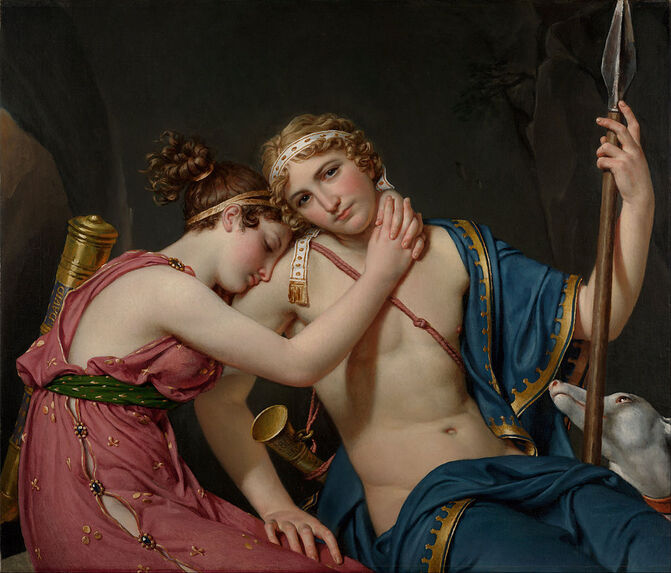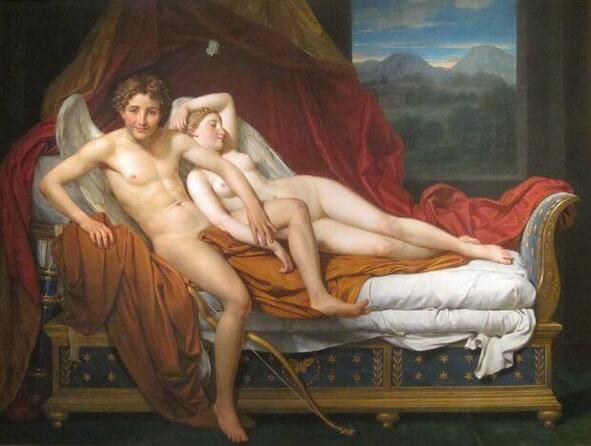|
Where? Room S204 of the J. Paul Getty Museum
When? 1818 Commissioned by? Unknown. However, just before David finished the painting, it was bought by Franz Erwein, Count of Schonborn-Wiesentheid, a politician and art collector from Germany. What do you see? The beautiful nymph Eucharis is on the left. On the right is the muscular Telemachus, the son of Odysseus and Penelope. Telemachus and Eucharis are in love with each other and say their final farewell in a dark cave before Telemachus will leave to continue the search for his father. Eucharis has her head on his shoulder and her eyes closed while embracing Telemachus. She wears a red dress (called a chiton), which is held together on the side and the top by jeweled clasps. She also wears a green sash which accentuates the shape of her breasts. On her back is a golden quiver, inscribed with the last name of Jacques-Louis David. Telemachus has golden, curly hair with a decorated hairband is bear-chested, and wears a blue garment with golden edges. He has his right hand on her thigh, and he holds his spear with his left hand. Telemachus already seems to be thinking about the future and looks at the viewers of this painting. On his back, he wears his golden horn, which is inscribed with the year and the place at which the painting is created (1818, Brux.). On the right is the white hunting dog of Telemachus. He looks at Telemachus to support him at this moment. Backstory: According to Jacques-Louis David, he created this work to complement his painting Cupid and Psyche from 1817 in the Cleveland Museum of Art. He created Cupid and Psyche for an Italian art collector, count Sommariva, but there is no evidence that the painting on Eucharis and Telemachus was also intended for him. In 1818, Franz Erwein visited the studio of David just before he finished the painting of Eucharis and Telemachus and bought it. The Getty Museum acquired this painting on an auction in 1987 for a little bit over $4 million. The last time the painting was sold before that, in 1950, was for only $3,950 to a private dealer.
The story of Eucharis and Telemachus? Telemachus is the son of the Greek hero Odysseus and his wife, Penelope. He is well-known because, in the first four books of the Odyssey (Amazon link to this book) by Homer, he searches for his father. Odysseus had left for Troy when Telemachus was still a baby and was already gone from home for 20 years.
The story in this painting by Jacques-Louis David is inspired by the popular French book Les Aventures de Télémaque, fils d’Ulysse, translated as The Adventures of Telemachus, Son of Odysseus (Amazon link to this book). François Fénelon wrote this book in 1699, and it fills in some of the gaps in Homer’s Odyssey, specifically the extensive travels of Telemachus to find his father. While they are on the isle of the goddess Calypso, Cupid makes Eucharis and Telemachus fall madly in love. However, at some point, Telemachus needs to leave to continue the search for his father, Odysseus, and they arrange a final moment to say goodbye to each other. Interestingly, though, this specific moment of goodbye is not described in the book by Fénelon. Who is David? Jacques-Louis David was born in Paris in 1748 and died in Brussels in 1826. He is a Neoclassical painter and had a large number of students, including Jean Auguste Dominique Ingres. He mainly painted portraits, historical scenes, and mythological scenes. An example of the latter is The Death of Socrates in the Metropolitan Museum of Art. David was a supporter of the French Revolution, and in 1804 he was appointed the court painter of Napoleon. There, he painted the famous The Coronation of Napoleon which is in the Louvre. When Napoleon was defeated in 1815, David moved to Brussels even though the new King, Louis XVIII, offered him a position as court painter. In Brussels, he continued to paint until his death.
Fun fact: David was politically engaged in his life and his paintings often contained moral and social messages. However, after he moved to Brussels, he lost his political influence in France and his painting style changed. He wanted to focus more on the composition of his paintings and enjoy the last years of his life peacefully, without painting deeper political messages.
The Farewell of Telemachus and Eucharis painting seems to have two relatively straightforward symbolic messages.
Written by Eelco Kappe
References:
0 Comments
Leave a Reply. |
Categories
All
|
- Home
- Blog
-
Museums
- Alte Pinakothek
- Art Institute of Chicago
- Baltimore Museum of Art
- Barber Institute of Fine Arts
- Bargello
- Barnes Foundation
- British Museum
- Church of Sant’Anastasia
- Cleveland Museum of Art
- Courtauld Institute of Art
- Detroit Institute of Arts
- Frans Hals Museum
- Galleria Borghese
- Gallerie dell'Accademia
- Getty Museum
- Guggenheim
- Hermitage Museum
- Kunsthistorisches Museum
- Kunstmuseum Basel
- Legion of Honor Museum
- Louvre
- Mauritshuis
- Metropolitan Museum of Art
- Musee d’Orsay
- Museum of Fine Arts in Boston
- Museum of Modern Art
- National Gallery in London
- National Gallery of Art
- National Museum in Poznań
- Norton Simon Museum
- Ny Carlsberg Glyptotek
- Palace of Versailles
- Palazzo Pitti
- Palazzo Vecchio
- Petit Palais
- Philadelphia Museum of Art
- Prado
- Pushkin Museum
- Ravenna Art Museum
- Rijksmuseum
- San Diego Museum of Art
- Santa Maria delle Grazie
- St. Peter's Basilica
- Städel Museum
- Statens Museum for Kunst
- Tate Britain
- Tate Modern
- Timken Museum of Art
- Uffizi
- Vatican Museums
- Wallace Collection
-
Artists
- Altdorfer
- Anguissola
- Berlin Painter
- Bosch
- Botticelli
- Boucher
- Bronzino
- Bruegel the Elder
- Brunelleschi
- Cabanel
- Caillebotte
- Canova
- Caravaggio
- Carpeaux
- Cezanne
- Cimabue
- David
- Degas
- Delacroix
- De Maria
- Donatello
- El Greco
- Fontana
- Fra Angelico
- Fragonard
- Gauguin
- Gentileschi
- Gericault
- Gonzalez-Torres
- Goya
- Hals
- Hogarth
- Hokusai
- Ingres
- Leonardo da Vinci
- Lippi, Filippo
- Longhi, Barbara
- Lorrain
- Makovsky
- Manet
- Massys
- Matisse
- Merian
- Michelangelo
- Mochi
- Modigliani
- Monet
- Panini
- Parmigianino
- Perugino
- Picasso
- Pisanello
- Raphael
- Rembrandt
- Renoir
- Reynolds
- Rivera
- Rodin
- Rubens
- Scultori
- Seurat
- Steen
- Tintoretto
- Titian
- Toulouse-Lautrec
- Turner
- Uccello
- Van der Weyden
- Van Dyck
- Van Eyck
- Van Gogh
- Van Hemessen
- Vasari
- Velazquez
- Vermeer
- Veronese
- Vigée Le Brun
-
Locations
- Books
- About Us




